Can We Update Formula Field In Salesforce Using Flow
I wish there is a smart formula builder where we tin can but say "I need a formula in flow that does this and that", and so "Nail!" it generates that formula for u.s.a. automatically. Sadly, it doesn't be (or yet?), so it becomes an important mission to familiarize ourselves with formulas. It's a never-ending journeying which requires a lot of inquiry, and so in this article, I want to list downwards all the formulas that I normally use, and how to combine them to create avant-garde formulas.
I will constantly update this article. If there are any powerful formulas that yous often use but are not here, please share with united states of america!
Commonly used or Prissy to know Formulas
Here is the official list of all formulas. I will follow a similar categorizing strategy:
- Text Operators
- & / +
- Logical Functions
- IF
- CASE
- ISBLANK
- BLANKVALUE
- AND / OR / Not
- Text Functions
- TEXT / ISPICKVAL
- BR
- BEGINS / CONTAINS / INCLUDES
- SUBSTITUTE
- TRIM
- LEN
- Notice
- LEFT / Right / MID
- Return Substring
- Number Functions
- VALUE
- CURRENCYRATE
- Date and Fourth dimension Functions
- + / –
- ADDMONTHS
- DATE
- YEAR / MONTH / 24-hour interval
- WEEKDAY
- TODAY / At present
- Notice Upcoming Friday
- Tips of Formula Building
* Text Operators
- & or +
I want to mention this considering it is the easiest yet a very powerful way to create a cord. You can employ & or + to connect several strings into i. If y'all need to add a literal string in between, use "" to wrap this literal cord. For example, to add an empty space, use " ".
Formula Case
{!Lead.FirstName}+" "+{!Lead.LastName} {!Atomic number 82.FirstName}&" "&{!Lead.LastName} Back To Listing
Result
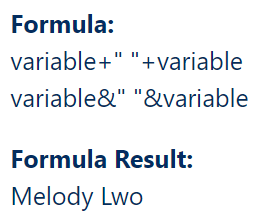
* Logical Functions
- IF ( equation , result if true , consequence if fake )
This has to exist the most commonly used formula (as to the lowest degree by me). Yous enter iii arguments – start is the expression to be evaluated, then the desired results based on whether the expression is True or False. Sometimes we can fifty-fifty create nested IF formulas.
Formula Example
IF ( var = x, "It is X!", "It is not ten")
Dorsum To Listing
Event
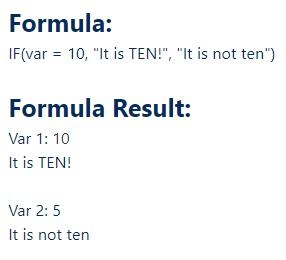
- CASE ( target, scenario one, result 1 [, scenario 2, outcome 2] … , general result )
If y'all notice yourself using too many nested IF, consider CASE() instead. In that location are three parts for this formula – first is the target that needs to be evaluated. Then two arguments for each scenario. Finally you lot add a grab-all argument for other scenarios that are not listed.
Formula Instance
Instance ( var, ten, "It is TEN!", 5, "It is Five!", "Not 10 nor five")
Dorsum To Listing
Event
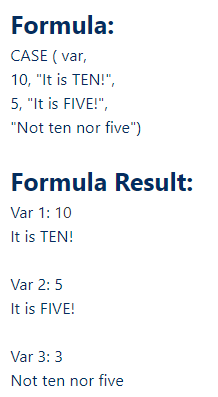
- ISBLANK ( target )
This returns True or False based on the target yous make full in. Use ISBLANK instead of ISNULL.
Formula Example
ISBLANK( var )
Back To Listing
Result

- BLANKVALUE ( target , result if blank )
If the target is bare, return the specified value. This is the equivalent of IF ( ISBLANK ( target ), result if bare, target).
Formula Case
BLANKVALUE ( var )
Back To List
Effect
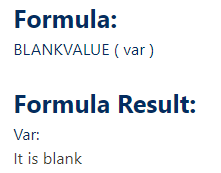
- AND / OR / Non
It is squeamish to know that these are interchangable:
AND ( A , B ) = A && B
OR ( A , B ) = A || B
Not ( A ) = ! A
* Text Functions
- TEXT ( ) / ISPICKVAL ( picklist field , specified value )
TEXT() is an important function to keep in mind. In that location are some restrictions of which formula can be used on which data type, and so if you lot bump into this error, attempt to convert the type into text. Here is worthy to notation that TEXT(picklist) = "A" is the same as ISPICKVAL(picklist , "A").
- BR ( )
This is just a nice to know formula. If you want to add an empty line in Menstruation text resources, you can use the BR() function. Yous treat this as a text, and so you tin can use & or + to connect BR() with other strings.
Formula Example
{!Lead.FirstName}&BR()&{!Lead.Email} Back To List
Upshot
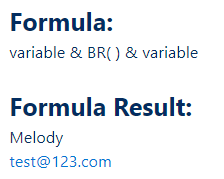
- BEGINS ( ) / CONTAINS ( ) / INCLUDES ( )
Here I want to mention their equivalence in the Decision Element:
BEGINS() = Starts with operator
CONTAINS() / INCLUDES() = Contains operator
Besides, CONTAINS() does not work for multi-picklist fields. We need to employ INCLUDES() instead.
- SUBSTITUTE ( target , text to exist replaced , text to replace )
Replace whatsoever characters in your string into other characters! You can as well remove the empty spaces inside a string.
Formula Case
SUBSTITUTE({!Pb.E-mail}, "test", "replaced") SUBSTITUTE( target , " ", "")
Back To List
Result

- TRIM ( target )
Remove the spaces and tabs from the showtime and finish of the target. If you lot want to remove the spaces inside the target, use SUBSTITUTE() instead.
- LEN ( target )
This returns the number of characters of the target – spaces and symbols are all included. Information technology can too exist used to summate the length of a drove. The length is an important data when we want to work with the index of a string.
Index is the position of a specific character in a string. In Apex or other programming linguistic communication the index starts from 0, just in Flow it starts from 1. By knowing the length of a string, nosotros volition know the range of the alphabetize of that string. For example, if the length is 10, we know the index is 0-9, but in Flow it is ane-10.
Formula Example
LEN({!Lead.Name}) Back To List
Effect
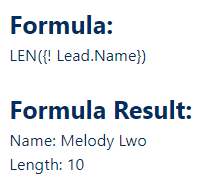
- FIND ( target [start position] , graphic symbol(s) to find )
This part returns the index of the specific graphic symbol you desire to observe. You lot can search for but one graphic symbol (ex. @) or a cord (ex. com). If you search for a string, it will return the position of the kickoff character of that string. Yous can besides specify a kickoff position to skip part of the target string.
Information technology is very handy when nosotros are working with some avant-garde text formula.
Formula Case
Detect({!Lead.Name} , "M") Detect({!Pb.Proper name} , "Lwo") Back To List
Result
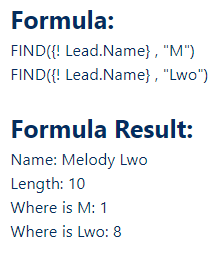
- LEFT ( target , number of grapheme to return ) / RIGHT ( target , number of character to return ) / MID ( target , kickoff position , number of character to return )
These three are very powerful functions. You can return a specific number of characters from the target cord, either starting from the left, the correct, or the centre.
For MID(), the get-go grapheme will be included as well. For example. MID("How-do-you-do", 2 , 2) volition return "el".
Formula Instance
LEFT({!Lead.Name},iii) Correct({!Atomic number 82.Proper noun},3) MID({!Lead.Proper noun},iv,3) Back To List
Result
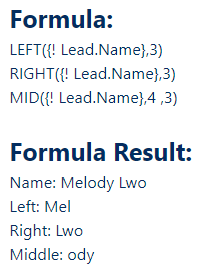
- Return Substring
Combining LEN(), Observe(), LEFT()/RIGHT()/MID(), we can get a specific substring of a string variable. This applies to many employ cases:
Go my org's url:
The $Api.Partner_Server_URL_530 variable returns the endpoint of your Salesforce org. This formula is saying "Starting from the left of the entire URL, return the characters all the way until the position of "/services".
LEFT({!$Api.Partner_Server_URL_530},Notice("/services", {!$Api.Partner_Server_URL_530})) Upshot

Go the electronic mail domain:
The previous formula is easy, because the position of a grapheme is the same equally "how many characters are in front end of this position" . However, since email domain is on the correct side, we have to calculate "how many characters are after this position".
We can attain that past using LEN( target ) – Discover ( graphic symbol to find , target ). Then we employ the Correct() function to get the domain.
Include @: Right({!Atomic number 82.Electronic mail}, LEN({!Lead.Email}) - Observe("@",{!Pb.Electronic mail}) + 1) Not Include @: RIGHT({!Lead.Email}, LEN({!Lead.Email}) - FIND("@",{!Atomic number 82.Email})) Back To List
Upshot
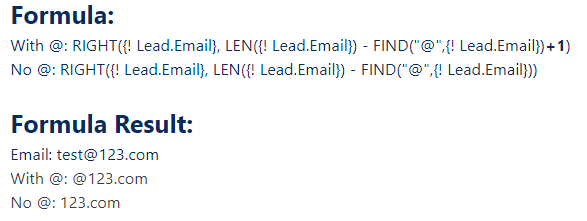
* Number Functions
- VALUE ( )
Similar to the TEXT() that turns the variables into the text type, VALUE() turns them into the number type.
- CURRENCYRATE ( currency lawmaking )
This is a function that might get forgotten easily, simply you can use this to convert the currency fields into the desired currency. It requires 2 steps – starting time to divide the conversion rate of the original currency then the value converts to the default currency. And then you multiple it by the desired currency conversion rate.
Formula Example
currency field / CURRENCYRATE(original currency lawmaking) * CURRENCYRATE(desired currency lawmaking)
Ex. To convert values from EUR to NOK: value in EUR / CURRENCYRATE("EUR") * CURRENCYRATE("NOK") Note: you lot can usually combine this function with the CurrencyISOCode field: Ex. CURRENCYRATE( TEXT ( {!Lead.CurrencyIsoCode} ) ) Dorsum To List
Outcome

* Date and Time Functions
- + or –
Yous can actually utilize + or – to modify the appointment. Continue in mind that the unit is always Solar day (so + 1 is add together one day). If y'all desire to add hours or minutes, employ 1/24 or 1/1440.
Formula Example
TODAY() + 1
Back To List
Outcome
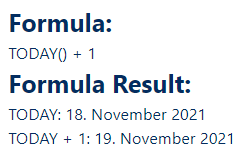
- ADDMONTHS ( date , number of months to add )
But if yous want to add together/minus months, using +/- might not be accurate since each calendar month has a different length. In that example, use ADDMONTHS() instead. Note that at that place is no minusMonths() but the number can be negative.
Formula Example
ADDMONTHS(TODAY(), 2)
ADDMONTHS(TODAY(), -2)
Dorsum To List
Result

- Appointment ( twelvemonth , month , day )
You tin enter iii numbers and go far into a engagement.
Formula Instance
DATE(2019, 1, ane)
Back To List
Event
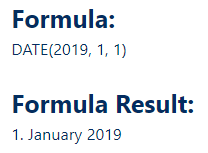
- Yr ( appointment ) / Month ( date ) / DAY ( date ) …
Yous can return the year, month, or solar day of a date and turn it into a number. These is very helpful together with the DATE() function – Ex. to return the commencement of current/next yr, or the first of electric current/adjacent month.
Formula Example
First of this year: Appointment(Twelvemonth(TODAY()),1,1)
First of next year: DATE(YEAR(TODAY())+1,one,i)
Commencement of this calendar month: DATE(Yr(TODAY()),Calendar month(TODAY()),1)
First of next month: IF(Calendar month(TODAY()) = 12, DATE(Year(TODAY())+one,one,ane), DATE(YEAR(TODAY()),Calendar month(TODAY())+1,one))
Back To List
Result
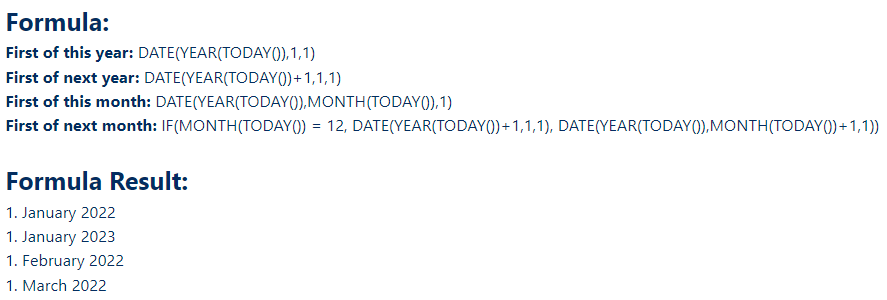
- WEEKDAY ( appointment )
This returns the number of weekday from a specific date – 1 for Sunday, 2 for Monday,… 7 for Saturday. This is a very important function for the advanced date adding.
- TODAY ( ) / Now ( )
TODAY() returns date and Now() returns date/time. Alternatively, you can also utilize the $Catamenia global variable to become the current appointment or date/time.
Formula Example
TODAY() or {!$Flow.CurrentDate} At present() or {!$Flow.CurrentDateTime} Back To List
Result
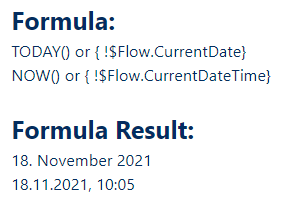
- Find Upcoming Fri
To be honest with you, date-related formulas are my least favorite. It is usually very circuitous and we have to consider many scenarios. Salesforce even has a whole article to share some examples, and it is just the tip of the iceberg. Just I am sharing ane formula that I really similar – to find the next specific weekday!
Formula Instance
The concept is quite straightforward – in any week, the difference between two dates volition exist the same as the difference of their weekdays, so the equation is Date 1 – Engagement 2 = Weekday (Date one) – Weekday (Engagement 2). If we want to know the Friday of the same week, it becomes: Target Appointment – Today = 6 (Weekday for Friday) – Weekday (Today). Then motility all the known numbers to the right: Target Date = Today + 6 – Weekday(Today)
And then to think about the upcoming Friday, we have to consider if the Friday this week has passed. If it has, add seven days to get the Friday next week.
Upcoming Fri: IF(WEEKDAY(TODAY())<=6, TODAY() - WEEKDAY(TODAY()) + 6, TODAY() - WEEKDAY(TODAY()) + vi + seven)
If you want to detect another weekday, but switch the X in the below formula. (Annotation: i is Sun)
Upcoming ____day: IF(WEEKDAY(TODAY())<=X, TODAY() - WEEKDAY(TODAY()) + X, TODAY() - WEEKDAY(TODAY()) + X + seven) (10 is the number representation of that weekday)
You can likewise extend this formula to get the Friday after Y weeks by adding Y * vii.
Back To List
Result

- Tips of Formula Building
Hither are some tips of how to build formulas more than efficiently:
1. Build them in a Screen Flow:
I like to employ a Display Text component to check if my formula works properly. This volition eliminate many potential errors (ex. wrong indexing) and shorten the troubleshooting time.
two. Use formula builder from whatever object or a custom component
Catamenia Architect is getting improve at detecting the errors, merely the errors don't preclude us from saving a formula resource. In this instance, I will sometimes go to whatever object and utilize the formula builder when creating a new field. It is a nice method when you are simply starting with formula (call up not to save that field of course).
Alternatively, y'all tin consider this custom component that enables you to build formula direct in Catamenia.
3. Do A LOT of inquiry and testing
As mentioned in the beginning, information technology does requires a lot of exercise to become proficient in formula building. Attempt to research and test every bit much equally possible, and note down some proficient formulas that you have seen (You will give thanks yourself!). Here is another example canvas from Salesforce. Also, remember in that location are some formulas we cannot use in Menstruation.
Is This Helpful? Check Out Flow Use Cases Or Write Us One!
Source: https://salesforce-flowsome.com/formula-that-is-commonly-used-or-nice-to-know-in-flow/
Posted by: portillofratirld.blogspot.com

0 Response to "Can We Update Formula Field In Salesforce Using Flow"
Post a Comment